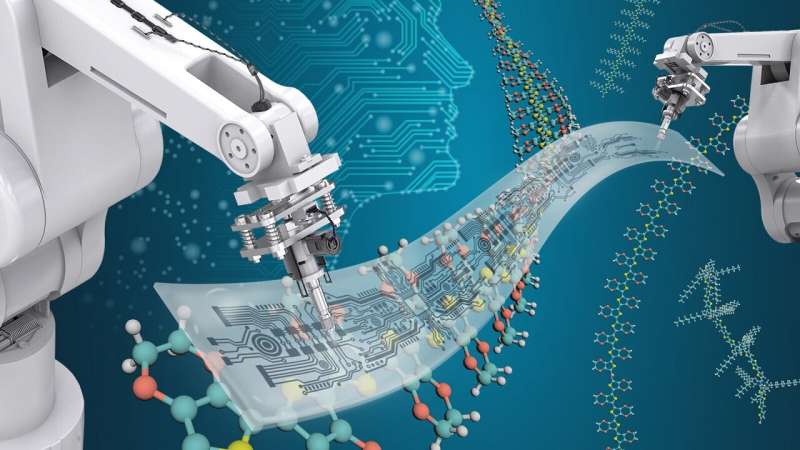Self-driving lab accelerates the discovery process for materials with multiple applications

Researchers have a new scientific tool called Polybot, combining the power of artificial intelligence with robotics. Potential applications include speeding up the discovery of wearable biomedical devices, materials for better batteries and more.
Today’s wearable technologies like smart glasses and watches are just the start. The next generation of flexible electronics will be more efficient and sustainable, better able to monitor our health and treat certain diseases, and much more. They will be composed of electronic polymer materials—a soft pliable substance that can conduct electricity.
“Just imagine the next generation of polymer electronics,” said Jie Xu, assistant chemist at the U.S. Department of Energy’s (DOE) Argonne National Laboratory with a joint appointment in the Pritzker School of Molecular Engineering at the University of Chicago. “They are not going to be rigid anymore.”
To hasten the discovery time, researchers at Argonne have a new tool, a self-driving laboratory called Polybot that automates aspects of electronic polymer research and frees scientists’ time to work on tasks only humans can accomplish. This tool combines the computational power of artificial intelligence (AI) with the automation possible with robotics. It is housed in the Center for Nanoscale Materials (CNM), a DOE Office of Science user facility at Argonne.
In an article published as the cover story in Chemistry of Materials, Xu and Henry Chan, a CNM assistant scientist, along with researcher Aikaterini Vriza, shared their vision on using self-driving laboratories for different types of materials research.
Polybot is one of several autonomous discovery labs starting up at Argonne and other research organizations. While still in their infancy, their main purpose is to harness the power of AI and robotics to streamline experimental processes, save resources and accelerate the pace of discovery.
The potential applications of Polybot extend far beyond biomedical devices, Xu said. They include materials for computing devices with brain-like features and new sensors for monitoring climate change. They also include new solid electrolytes that would eliminate the current liquid electrolyte in lithium-ion batteries, making them less likely to catch fire.
Using Polybot, the CNM team is focusing on polymer electronics for energy-saving and medical purposes. These include devices that are recyclable or decompose after use.
Scientists usually prepare polymers for electronics by synthesizing polymer molecules with desired chemical structures, creating a solution with a mixture of many components. They then convert the solution into a thin layer of solid material. Layers of different compositions printed together serve as the basis for making different types of devices.
To achieve targeted performance, the number of potential tweaks is overwhelming. They run from spiking the fabrication recipe with different formulations to varying the processing conditions. By conventional experimental means, such development can take years of intense labor. Polybot can greatly reduce the development time and cost.
A typical experiment with Polybot begins by using AI and robots for different tasks. The automated system chooses a promising recipe for a polymer solution, prepares it and prints it as a very thin film at a selected speed and temperature. The system then hardens this film for an optimal length of time and measures key features, such as thickness and uniformity, as a quality check. Next, it assembles multiple layers together and adds electrodes to form a device.
After that, Polybot measures the device’s electrical performance. All the relevant data are automatically recorded and analyzed with machine learning and passed to the AI component. The AI then direct what experiments to do next. Polybot can also respond to feedback provided by users and data from the scientific literature.
“This is all done with minimal human intervention,” Xu said.
“We have plans in place to expand the capabilities of our self-driving lab to take advantage of other Argonne scientific facilities,” said Chan.
Already, the properties of electronic devices fabricated in Polybot have been analyzed with a powerful X-ray beam. This was done by using an instrument with a robotic sample handler at the Advanced Photon Source (APS), a DOE Office of Science user facility at Argonne. That connection could be strengthened to take full advantage of the APS after its upgrade is complete in 2024.
“X-ray scattering analysis expands the Polybot’s characterization down to the molecular level, revealing information about the orientation and packing of the molecules that can help speed up the search for the best materials with optimal performance,” said Joseph Strzalka, a physicist in Argonne’s X-ray Science division. “We are working on bringing the Polybot’s capabilities to an APS beamline so we can generate the large numbers of materials the APS upgrade will be capable of studying.”
“We are excited at the prospect of leveraging the supercomputing capabilities at Argonne to enhance Polybot,” Chan explained. “The goal is to conduct physics-based simulations prior to, during and after an actual experiment to gain deeper insights into a material or device and provide better feedback to the AI.” The team plans to utilize the Argonne Leadership Computing Facility, a DOE Office of Science user facility, to perform the simulations. This will streamline the discovery process even further.
With these capabilities and more, self-driving labs like Polybot have the potential to accelerate the discovery process from years to months. They also could reduce the cost of complex projects from millions to thousands of dollars.
More information:
Aikaterini Vriza et al, Self-Driving Laboratory for Polymer Electronics, Chemistry of Materials (2023). DOI: 10.1021/acs.chemmater.2c03593
Citation:
Self-driving lab accelerates the discovery process for materials with multiple applications (2023, April 26)
retrieved 26 April 2023
from https://phys.org/news/2023-04-self-driving-lab-discovery-materials-multiple.html
This document is subject to copyright. Apart from any fair dealing for the purpose of private study or research, no
part may be reproduced without the written permission. The content is provided for information purposes only.
For all the latest Science News Click Here
For the latest news and updates, follow us on Google News.

